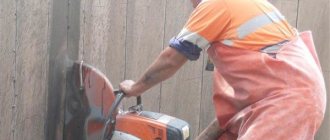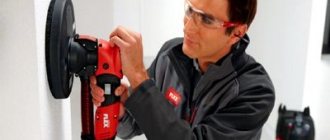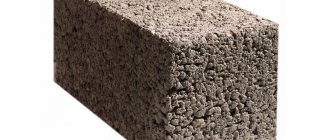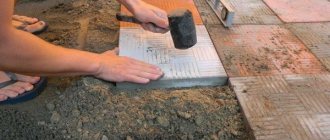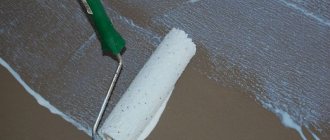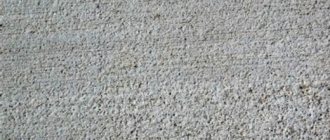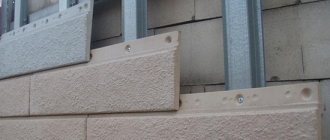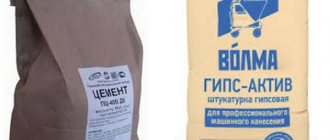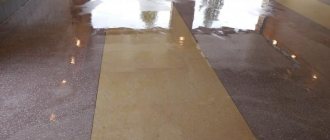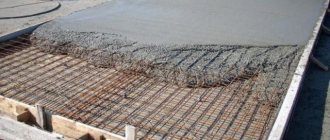Main areas of application of concrete polishing technology
Concrete is a natural material. Its main components are Portland cement, which is made from limestone and clay, and fillers (sand, gravel, crushed stone), obtained by crushing various rocks. Concrete also contains water, which ensures its hardening reaction. But, despite its naturalness, concrete has some flaws.
First of all, it has a rather unsightly appearance. For example, a concrete floor without any coating does not look very aesthetically pleasing. In addition, during operation such a floor becomes quite dusty . Now all these defects can be easily eliminated by grinding and subsequent polishing of concrete. Modern polishing technology allows you to preserve the naturalness of concrete, while eliminating all its main disadvantages.
Thanks to polishing, concrete began to be used as an independent floor covering
The visual characteristics of a polished concrete floor are almost identical to the external characteristics of natural stone. This floor looks truly beautiful and expensive, and its technical characteristics provide high resistance to mechanical and other influences. As practice shows, floors made of polished concrete successfully withstand both intense pedestrian traffic and the movement of heavy forklifts , therefore they are ideal for public entertainment venues and industrial workshops.
Currently, polished concrete floors are widely used in:
- production and warehouse premises;
- office buildings and business centers;
- supermarkets and boutiques;
- restaurants, bars and cafes;
- exhibition halls and museums;
- garages, parking lots;
- medical and educational institutions;
- sports complexes;
- hotels, train stations and airfields;
- residential premises.
Grinding the concrete surface
Grinding of concrete floors begins only after the base has completely hardened. The work itself can have up to 15 steps. It all depends on the base surface.
The job of creating polished concrete floors begins with preparation. And the first thing you should think about are the tools, without which the process is impossible:
Scheme of pouring, compacting and grinding a concrete floor.
- a grinding machine that will have corundum or diamond coating on the segments;
- milling equipment complete with carbide tools;
- corundum brushes;
- equipment designed for polishing concrete floors and having diamond discs;
- protective equipment: eye glasses, a respirator and preferably gloves.
You should know that if there are deep wave defects on the base surface, you will have to add an additional concrete layer. Any stripes that remain after milling will be removed during the concrete grinding process.
During preparation, the base base is cleaned: any contaminants are removed from the surface, and if there are paint residues, they are removed with a solvent. To carry out such work, a milling machine is used, since only it is capable of leveling the surface.
When grinding a concrete floor, the top layer, which is hardened cement laitance, is removed.
If you do not get rid of it, it will prevent the sealant from entering the molecular structure of the cement. Sanding exposes fillers such as chips and crushed stone.
Direction of concrete grinding.
It is immediately worth noting that before starting grinding work, the concrete is left alone for 7-20 days. This is necessary so that the surface of concrete floors acquires the required strength, since small components (limestone, crushed stone, gravel, etc.) may not have time to remain in the structure.
As for the processing tool itself, it is selected in accordance with the brand of cement used. If you are working on the floors yourself, then it is better to give preference to concrete grade M300. By the way, if for some reason you cannot acquire equipment or rent it, grinding can also be done with metal brushes. Although this will take a lot of time and effort.
Preparation of the subfloor should only be done with dry cement.
It may also happen that the base will be dirt, then the preparation will be like this:
- First of all, you need to compact the soil. This is done in order to avoid the appearance of cracks in the foundation in the future.
- Next you need to create a sand cushion. To ensure the required density, the material is laid 1/4 more than the design layer itself. It must be moistened with water and compacted. To do this, use a special roller or tamping tool.
Polished concrete: technology and advantages
Concrete polishing technology makes it possible to transform a concrete base into an impressive floor covering with a high level of durability. It should be noted that a polished floor can also be obtained on an old layer of concrete . The main thing is that it is still strong enough and has the necessary strength.
Polished concrete floors combine high resistance to abrasion, mechanical stress and dust separation with excellent decorative properties. They often imitate granite and marble floors, but at the same time surpass them in colors and patterns.
Advantages of polished concrete floors:
1. Durability and wear resistance of floors.
- polished concrete can last a very long time. After 5-7 years of operation, it may only need light repairs, consisting of impregnation and polishing of the surface;
- Polished concrete floors are highly resistant to scratches and are therefore very easy to use. They are able to withstand the movement of various heavy loading and transport equipment;
- Compared to regular concrete, polished concrete is more resistant to abrasion;
- the use of impregnations allows you to create a protective layer on the concrete surface that prevents the formation of erosion and dust.
2. Wide range of applications . Polished floors are distinguished by the most even and smooth surface, which eliminates high vibrations during operation of various mechanisms. This property, combined with many other positive characteristics, allows polished floors to be used in various areas.
Polished concrete is highly resistant to almost all major chemicals
3. Environmental friendliness . The undoubted advantage of a polished concrete floor is its naturalness. It contains no organic substances or solvents that can decompose over time or under the influence of temperature, or release odors or allergens.
4. Hygiene and safety . Rooms with polished concrete floors have a welcoming atmosphere because the material is able to allow air to pass through and release moisture that evaporates from its surface naturally. Its high pH level eliminates the possibility of the accumulation of mold, fungi, and various bacteria.
5. No alkaline dust . When concrete hardens, a cement film forms on its surface, which becomes a source of dust during the operation of the concrete surface. When polishing, this drawback is eliminated with the help of special impregnations. This strengthens and removes dust from the concrete surface, helping to clean the air in the room.
6.Ease of maintenance . Polished concrete does not require complex maintenance. It is easy to clean thanks to its absolutely smooth surface.
7. Visual appeal . The decorative effect of a polished concrete floor lies in its shiny surface. The option of engraving the floor, painting or stenciling is also possible. Using dyes, concrete can be painted in a wide variety of colors and patterns. This increases the demand for polished floors in places where the visual appeal of the floor covering is very important.
8. Economical.
- polished concrete floors can save up to 15% on lighting. This is facilitated by their high reflective abilities. Compared to conventional floors, polished concrete has a 30-50% higher reflectivity;
- since polished floors do not require complex maintenance, this significantly reduces the cost of their maintenance;
- the installation of polished concrete floors does not involve the use of expensive polymers or coatings. The cost of the impregnations used is relatively low, which is economically beneficial;
- polished concrete has a fairly long service life. Unlike traditional flooring, it does not require periodic renewal due to wear and tear. This also reduces floor maintenance costs.
Polished floors are quite competitive with conventional coatings in price
9. Low slipperiness . The use of special compounds makes it possible to obtain a floor covering whose slipperiness is 40-50% less than other floors.
10. High temperature resistance . The use of impregnations has a positive effect on the heat resistance of a concrete floor.
The process of creating a polished concrete floor consists of a number of steps. The technology depends largely on the conditions in which the floor will be used: outdoors or indoors, as well as the condition of the original surface - repairing an old floor or working with a new screed.
Briefly, the technology for creating a polished concrete floor can be presented as follows:
- the top layer of concrete is removed using a grinding machine until the filler grains are exposed;
- The concrete surface is strengthened with a special impregnator. This significantly increases the strength of the material and binds lime, which is a source of dust;
- multi-stage processing of concrete with a gradual reduction in the abrasiveness of the material used.
The result is an impressive and practical surface that does not require special care or restoration over a long period of time. High-quality polished concrete is not inferior to natural stone coatings, and in some respects even surpasses them.
When polishing concrete:
- the stone filler is exposed (it can be granite, quartz, corundum, marble), so this filler will take on all the main load experienced by the floor. As a result, the strength of the concrete floor will be similar to that of stone;
- due to the exposure of natural stone fillers, the concrete floor acquires a very impressive appearance, that is, it will also match the beauty of the stone covering;
- As a result of polishing, the concrete floor acquires a mirror surface, which further complements the decorative effect of the coating.
The first concrete polishing technology called Superfloor was proposed by NTS. This was more than twenty years ago. Today, many manufacturers of grinding machines offer their own methods. Properly selected technology ensures not only success in work, but also great savings in money and time.
Concrete polishing using NTS Superfloor technology
Concrete processing using this technology includes 5 stages.
Stage 1. Removal of old coatings and rough grinding of concrete.
First, the existing old coatings (paint, epoxy resin, glue, etc.) are removed and rough sanding is performed.
Stage 1.
At this stage, the old coating is removed using a 25 Grit diamond tool.
Stage 2.
Performing rough grinding with 80 Grit tool.
Stage 2. Sanding.
At this stage, the concrete is polished to obtain a smooth surface. The stage consists of two stages using a different tool in each of them.
Each grinding operation is performed 2 times: first along and then across the floor surface.
Stage 3.
Sanding with 150 Grit tool.
Stage 4.
Sanding with 200 Grit tool.
Stage 3. Application of strengthening impregnation.
Use NTS Cure impregnation. The drying time of the impregnation is 24 hours, so take a break for a day.
Stage 5.
The impregnation is applied carefully, without forming puddles on the surface of the screed.
Stage 4. Polishing the concrete.
Polishing is performed using diamond tools of different grain sizes. Each operation is performed twice: along and across the floor surface.
Stage 6.
Polishing with 400 Grit tool.
Stage 7.
Using 800 Grit tools.
Stage 8.
Switching to 3000 Grit tools.
Stage 5. Application of a protective composition.
At the final stage, a special impregnation is applied to the concrete floor to protect the floor and prevent its premature wear.
Stage 9.
One of the following compounds is applied to the polished concrete floor: HTC Cleaner, HTC Stain Protction, HTC Pore Primer.
The NTS company has developed four methods for creating polished concrete floors:
- Superfloor Bronze . This technology involves a minimum number of processing steps. During this treatment, the top layer of concrete is not removed, but polished. To obtain a polished surface, the concrete base is first ground, then NTS Cure impregnation is applied and polished with a tool from 400 to 3000 Grit. At the final stage, protective impregnation Stain Protection or Pore Primer is applied;
- Superfloor Silver . This method involves grinding but eliminates polishing. When making a floor using this method, two stages of surface preparation are performed, applying HTC Cure impregnation, sanding and applying a protective coating with Stain Protection or Pore Primer;
- Superfloor Gold . This technology skips the rough grinding stage, so the floor surface must be smooth and even before polishing begins. The treatment involves three stages of sanding, application of HTC Cure impregnation, three stages of polishing and application of Stain Protection or Cleaner;
- Superfloor Platinum . When creating a polished floor using this method, all stages of grinding and polishing are used. These are two stages of surface preparation, two stages of sanding, application of HTC Cure impregnation, three stages of polishing and application of Stain Protection or Cleaner.
Polishing concrete using technology from the Russian company Adel
The Adele company practices its own technical process, consisting of six grinding transitions using metal-bonded tools.
Adele has a technology for two to six polishing passes using non-metallic tools
Additionally the following can be implemented:
- stage of introducing a strengthening composition;
- stage of sealing cavities in concrete;
- the stage of introducing various chemicals (when making an appropriate decision).
Stage 1.
Removing uneven surfaces and bringing the floor surface to a flat plane.
At this stage, Frankfurt GFB 00 with 12 Grit grain is used. This tool is designed for rough peeling of concrete with the removal of large allowances.
Stage 2.
Smoothing out deep scratches remaining after the transition to GFB 00.
The tool used is GFB 0 with 30 Grit. This tool is used to remove weakened layers of concrete and cement laitance.
Stage 3.
Smoothing the concrete surface.
The tool used is GFB 1 with 50 Grit.
Stage 4.
Fine grinding.
GFB 2 transition with 120 Grit grain is used. Grinding with the GFB 2 tool is the 1st stage of polishing.
Stage 5.
Applying hardening impregnation to the floor surface.
Conditions for applying impregnation may vary depending on the choice of this composition. In any case, you should follow the recommendations of the manufacturer of the selected impregnation.
For example, the LITSIL company offers the following rules for applying LITSIL H15 impregnation:
- the floor surface must be prepared and sanded to a degree of 80-200 Grit;
- impregnation consumption depends on the condition of the surface and ranges from 0.06 to 0.2 l/m2;
- the impregnation must be evenly distributed over the floor surface using a brush;
- the impregnation must remain on the surface for at least 30 minutes in a liquid state. During this time, dry spots should not be allowed to appear on the surface of the concrete. If such places appear, the composition should be applied to them until a shiny wet film appears;
- After the surface treatment time has expired (0.5 hours of impregnation remaining on the surface in the form of a wet film), the remaining composition should be removed using a washing vacuum cleaner or scrubber dryer. The concrete surface must be washed with water. Dried impregnation does not dissolve in water, so it can only be removed mechanically;
- After treatment with impregnation, you must wait until the surface dries. Its drying time can range from thirty minutes to several hours. To achieve additional strength for the concrete, it is recommended to let the surface stand for at least 8-10 hours. After drying, the surface is completely ready for further processing.
Stage 6.
Sealing cavities and pores in concrete.
A certain number of cavities and other small defects are always present on the surface of concrete.
To obtain a high-quality polished surface, cavities and pores should be eliminated
The Adele company has developed the following method for sealing cavities and pores in concrete:
- applying a binder solution to the surface to be treated. The solution can be used, for example, LITSIL S70;
- applying a small amount of clean dry cement. The result is a cement mass, which is used to seal existing defects;
- After the putty has dried, the surface is sanded with a GFB 2 tool.
Stage 7.
Polishing.
GFB 3 transition with 200 Grit grain is used.
Stage 8.
Polishing.
GFB 4 nozzles with 400 Grit grain are used. This stage is the last one at which a metal-bonded tool is used. Further processing is carried out with plastic polishing wheels.
Stage 9.
Polishing.
The sequential use of five polishing transitions with a sequential reduction of diamond grains is proposed:
400 Grit – 800 Grit – 1500 Grit – 3000 Grit – BUFF.
Stage 10.
Polishing with 800 Grit pad.
After this stage, a gloss appears on the floor surface. In many cases, this condition is quite satisfactory for customers. Further polishing is carried out to achieve a more shiny surface.
Stage 11.
Using the 1500 Grit pad.
Stage 12.
Polishing with 3000 Grit pad.
Stage 13.
Polishing with BUFF pad.
As a result, the floor surface becomes mirror-like.
To improve the polished surface it is possible to:
- enhancing shine by applying polish;
- application of various compositions in order to impart hydrophobic and other properties to the surface.
Adel company tool
All work is performed with diamond tools produced by the Adele company. This tool is designed taking into account the domestic characteristics of the material being processed and is used to solve a variety of problems in grinding concrete surfaces. Adel has been developing and manufacturing tools with diamond segments for more than ten years. At the moment it is the largest manufacturer in Russia and a leader in the field of concrete processing.
The company has developed a line of tool compositions for processing various concrete . Sanding attachments can be installed on different sanding machines.
To mark cutters, the main color of the cutter is used, which indicates the grain size of the diamond powder from which the cutting segments are made.
Marking of Adel cutters:
- The red color indicates the grinding tool number 00. The diamond grains from which the cutting segments of this tool are made are 1.5-2.5 mm in size. These cutters are designed for removing large allowances, so they are used to scrape concrete bases at the preparatory stage;
- black corresponds to tool number 0 with diamond powder grain size 630/500 µm. Such attachments are used for rough grinding;
- gray indicates number 1 with 415/355 µm grit. The main purpose of this tool is to change the surface roughness after processing with a milling cutter of the previous number;
- silver-colored nozzles with number 2 and grit 125/100, which are used for fine grinding;
- cutters number 3 with a grain size of 50/40, intended for fine grinding of the surface with transition to polishing, are marked in gold;
- Silver gold corner bits have 20/14 grit diamond segments and are used for polishing concrete before using resin bonded tools.
Adele has also developed several types of bonds for diamond segments:
- ligament C (standard). A tool with such a bond does not have an additional color on the corner of the cutter, that is, its entire surface has a primary color corresponding to the grain size of the diamond segments. The bond has medium hardness and average resistance to abrasive wear. Segments with such a bond are used for almost all types of grinding work on concrete, unless special processing requirements are presented;
- ligament M (soft). The corner of the cutter is painted blue. This bond is characterized by low hardness and abrasive resistance, therefore it opens well and is effective when working on durable concrete;
- T ligament (hard). The corner of the cutter is painted red. The bond has increased hardness and resistance to abrasive wear. A tool with such a bond is used for grinding abrasive or low-strength concrete;
- ligament B (bronze). The corner of the cutter is painted gold. This type of ligament is made on a bronze basis. Grinding segments with such a bond have low resistance to abrasive wear and high cutting ability. Used for removing old polymer floor coverings and for sanding over toppings.
Using a variety of bond and grit combinations, you can find attachments to suit virtually any concrete floor sanding task.
LITSIL concrete polishing technology
Stage 1. Sanding.
Using a grinding machine, the top layer of concrete is removed until the grains of the mineral filler are exposed. The surface is also leveled.
At this stage, the compressive strength of the concrete should be measured.
If the strength is less than 20 MPa, polishing may be ineffective
Sequence of work at the first stage:
- if necessary, seal cracks with epoxy;
- grinding with GFB 0 with 30 Grit on a metal bond. After sanding, the surface should be thoroughly vacuumed;
- grinding with 50 Grit tool (GFB 1 metal). After sanding, the surface must also be vacuumed;
- grinding with GFB 2 cutter with 120 Grit and metal bond.
Stage 2. Hardening.
The concrete base is treated with LITSIL H15 impregnation. This treatment strengthens and removes dust from the surface, makes it easy to polish and protects it from aggressive substances.
Rules for applying impregnation:
- the impregnation is applied using a low-pressure pneumatic sprayer. The material consumption should be 0.1-0.2 l/m2;
- the surface should be kept wet for 20 minutes. At the same time, care must be taken to ensure that dry areas do not appear on the surface.
Stage 3. Repair/sealing
This step is very important when creating a polished concrete floor. It allows you to level the surface as much as possible and repair all minor defects.
Sequence of work:
- LITSIL S70 impregnation is applied to the surface at a consumption of 0.1-0.3 l/m2, and then sprinkled with Portland cement. Cement consumption should be 0.4-0.9 kg/m2. The resulting thick mass is evenly distributed over the floor surface;
- without waiting for the putty mixture to dry, begin grinding the surface with a GFB 3 tool with a metal bond and a grain size of 200 Grit;
- The sanded surface must be vacuumed and inspected for defects larger than 5 mm. If necessary, treatment with the repair composition is repeated, but not less than twelve hours after the first treatment.
Stage 4. Polishing/polishing.
Surface polishing is performed in the following sequence:
- polishing with GFB 4 metal bonded tool and 400 Grit. The surface after treatment becomes smooth and semi-matte;
- To obtain a gloss on the surface, continue polishing with plastic pads (turtles);
- 400 Grit. The result is a semi-matte surface;
- 800 Grit. The surface becomes semi-glossy;
- 1500 Grit. The surface acquires a glossy shine;
- 3000 Grit. Glossy surface;
- BUFF (glossy shine).
The surface must be thoroughly cleaned between transitions.
Stage 5. Painting (if necessary).
To paint the surface or apply a pattern, the LITSIL D40 concrete tinting system is used.
The work is carried out in the following sequence:
- surface grinding with a 400-800 Grit tool with a metal bond. After each transition, the surface is cleaned with a vacuum cleaner;
- applying the coloring composition with a consumption of 0.15-0.3 l/m2. If it is necessary to obtain a more saturated color, the composition is applied several times until the desired shade is achieved.
Stage 6. Protection.
Applying a finishing polish to a concrete surface allows you to protect it from the effects of water and various aggressive liquids, and also increase the shine and aesthetics of the surface.
Sequence of work:
- the composition can be applied to a surface polished to a degree of 800 Grit, but better - up to 3000 Grit. The composition used is LITSIL S55. It is applied in two or three layers with a consumption of 0.2 l/m2 per layer using a pneumatic sprayer. Before each application of the next layer, you must wait for the previous one to dry (about 10-15 minutes);
- After applying the finishing coat, the floor surface must be left for 40 minutes and then polished using a high-speed polishing machine with a felt disc.
Equipment and tools used
For concrete polishing work, mosaic grinding machines are used. The main element of these machines is the grinding head, which consists of an electric motor and a two-stage gearbox. Crossbars with abrasive attachments are attached to the gearbox shafts. The degree of processing of the concrete surface with a mosaic machine depends on the type of nozzles.
Mosaic-type machines belong to the category of expensive grinding equipment and are used to perform delicate work. Compared to other types of grinders, mosaic grinders are better protected from dust, and many models are equipped with a built-in vacuum cleaner . However, the advantages of mosaic machines affect their cost and associated consumables.
Grinding machines are produced by many foreign and domestic companies. The highest quality equipment is offered by HTC, Husqvarna, and Schwamborn. Domestic Splitstone machines harmoniously combine good functionality with an affordable price.
There are professional and household grinding machines . Professional equipment is equipped with a disk with satellites, to which abrasive equipment is attached. The quality of surface treatment is ensured by the mutually opposite rotation of the main circle and satellites. The rotation speed of the tool can be adjusted. Professional grinding machines are equipped with a water supply and dust collection system during operation.
Household equipment is equipped with only one sanding disc. It is distinguished by its compactness and low cost, but, unfortunately, also by its low quality of processing. However, in some cases it can be difficult to do without household machines, for example, when processing hard-to-reach places in a residential area.
The productivity of grinding machines is significantly increased by the use of diamond tools . Diamond segments for grinding and polishing concrete are made from diamond grains of different sizes.
Depending on the grain size of the abrasive, the tool can be used for either coarse grinding or fine polishing
Features of polished concrete
Some compare polished floors with bases that are coated with special polymer compounds. However, it is worth saying that when choosing between these types of processing, preference should be given to polishing. The fact is that in the case of creating a polymer protective layer, the surface does not breathe, which in turn leads to the retention of water vapor. If we talk about polished concrete, then in this case the base will be freed from excess moisture, due to which the pH level in the room increases. In addition, no migrating chemicals, harmful bacteria, mold or fungi are formed on polished surfaces.
Also, it is worth paying attention to other advantages of polished and honed concrete floors:
- increased hardness and strength of the resulting surface;
- externally, polished concrete resembles marble, but is superior to it in impact resistance;
- the top layer of polished concrete, unlike polymer, is connected to the base to form a single monolith;
- thanks to polishing, the risk of abrasion is reduced;
In addition, polished concrete is resistant to chemical influences and can be easily repaired.
Coverings of this type are most often installed in warehouses, industrial areas, shopping centers, administrative and residential buildings.
At the same time, grinding and polishing can be done at home, provided that the cement-sand floor screed is properly prepared.
Safety regulations
When performing polishing work, it is necessary to clear the work area of any debris and unnecessary objects. When processing, care should be taken to ensure that no foreign objects get into the working area of the cutting tool, which could cause failure of quite expensive equipment.
Successful completion of work depends on compliance with the following safety rules:
- before work, it is necessary to carefully check the functionality of the equipment used and securely fasten the working tool;
- when using electrically driven mechanisms, it is necessary to carefully inspect it before work in order to identify exposed electrical wires or damage to their integrity;
- During operation, it is necessary to ensure that the working tool does not overheat. Overheating of the tool leads to its unsuitability for work (deformation), which can cause injury to the machine operator;
- if any defect appears on the working tool, it should be replaced, since using a damaged tool may cause injury;
- when carrying out work, it is necessary to take into account the location of communications that pose an increased danger (gas supply, electrical wiring, etc.);
- When using chemical compounds, you should be careful not to get them on the skin and especially in the eyes.
It is not allowed to work with the equipment if the switches are not functioning properly, or if there is extraneous noise, vibration or odor. It is also not allowed to work with a machine that has cracks in the body elements or loose fastenings of the working parts.
When performing concrete polishing work, you should always wear special work clothes made of thick fabric with long sleeves, as well as use respiratory protection masks, goggles and gloves.
Stages and features of work
A grinding machine is a fairly expensive tool, so to save money, you can rent it.
To make your own polished concrete floor, you need to follow these steps. First of all, by means of milling, the surface is thoroughly cleaned of dirt and small debris, including construction debris.
Next, you need to carefully examine the floor for damage: cracks, potholes, seams. If any are present, they must be eliminated using epoxy mastic. This is done to ensure that the base is perfectly level, otherwise the grinder head will slow down and jump. And this can significantly worsen the result.
At the first stage, rough grinding is carried out using diamond discs with a grain size of up to 37 microns. This process will generate a lot of dirt, so have an industrial vacuum cleaner on hand. If you use ordinary equipment, you will not be able to remove dust and debris perfectly. And the presence of contaminants will negatively affect the result of the coating.
It is necessary to carry out chemical treatment using a special hardener. This is done in order to reproduce the reaction of all the elements and calcium hydroxide, which will significantly increase the strength of the surface of the concrete floor.
In the future, it is necessary to treat the surface with an impregnator. Then it is necessary to grind using granular discs (37 microns).
After this, the surface of the concrete floors is processed using diamond wheels, grain size - 5-10 microns.
If the room is small, specialized polishing equipment can be replaced with a grinder. Although this will require longer time and greater effort. But it can be used to more accurately treat hard-to-reach places.
Do not forget that the surface must be carefully treated with waterproofing impregnation.
Cost of polished floors
The price of a polished concrete floor depends, first of all, on the initial condition of the screed (grade of concrete, hardness, evenness of the surface, the presence or absence of various defects on it). In addition, the cost is influenced by what result the customer wants to receive (matte surface or glossy, colored, decorated, etc.).
Cost of polishing concrete using different technologies:
| Contents of work | Cost, rub/m2 |
| Polished with HTC Superfloor technology to a matte finish | from 500 |
| Polished with Husqvarna Hiperflor technology to a semi-matte finish | from 700 |
| Polishing using Adele technology to obtain a mirror surface | from 600 |
| Creation of polished colored concrete floor using LITSIL technology | from 800 |
General characteristics
The quality of finishing of the room will depend on compliance with the grinding algorithm. Their essence is expressed in the elimination of the weakened top layer, which is not able to withstand the load sufficiently firmly. In addition, the top coating does not have any decorative appeal until it is processed.
You can do polished concrete yourself when installing a new coating, if it is necessary to remove the top fragile layer, which contains fine particles that are weakly held by the aggregate. Such work can also be performed to eliminate tubercles, as well as unevenness and other surface defects.
Polished concrete floors can be done by preparing the coating before applying the finishing material, which assumes ideal geometric parameters of the surface. Such manipulations can also be carried out in cases where it is necessary to increase the adhesion force, for example, before the formation of self-leveling floors. In addition, it can be noted that the dust suspension in the upper part can pose a danger to human health until it is removed. A worn-out concrete floor can be restored; to do this, the top destroyed layer is simply removed.
conclusions
Concrete polishing technology is a modern, reliable and most promising way to create flooring. This technology eliminates the need to apply any coating to the concrete base, which completely eliminates peeling, peeling or wear of the corresponding coating.
The hardness of polished flooring is almost the same as that of granite.
Polished concrete is practically no different in appearance and technical characteristics from natural stone floors . Accordingly, the wear resistance of polished concrete floors is significantly higher compared to all other traditional floor coverings. Thanks to these characteristics, polished concrete floors can be used in areas where there is heavy traffic of people or heavy loading equipment.
The nuances of polished concrete technology from Adele are shown in the video:
Factors affecting the condition of polished concrete
Any floor covering experiences daily stress from the passage of people and the passage of special vehicles. There is always a risk of mechanical damage to the surface, and polished concrete is no exception to the general rule. The main factors that reduce the strength qualities and aesthetics of the floor:
- Intense flow of visitors. This applies to trading floors for various purposes. The store, which sells building materials, food, furniture, and clothing, receives several dozen visitors every day.
- Strikes. Accidental falls of goods from shelves are a serious test for flooring.
- Thermal and physical effects. Sand on the floor, high temperature from working units of machines and mechanisms, snow and ice at the entrance to the warehouse terminal have a negative impact on the properties of the polished coating.
All manufacturers who work in the field of creating concrete coatings develop their own recommendations for the care of floors. It is important to know them and strictly follow them. Then polished concrete will not require major investments in repairs for several years.
Material selection
The technology of polished concrete involves choosing the thickness of the layer for grinding. According to building standards, this parameter is 3 cm, but more powerful options may be preferred. Pits and tubercles are acceptable, as well as differences, the difference between which is no more than 5 mm.
Before choosing a material for pouring a concrete screed, it is necessary to take into account the purpose of the object. For example, a monolithic floor in a garage, small warehouse or production workshop can be constructed using concrete graded in the range from M150 to M300. The same solution is also suitable for outdoor paths, as well as outdoor areas. The material is reliable for use and has priority characteristics for further grinding.
If higher strength requirements are imposed on the surface, then materials marked M300 or more can be used for the screed. When choosing a polished concrete recipe, you should take into account that the optimal aggregate is fine crushed stone. It may be igneous or metamorphic rock material.
If you plan to process the surface by polishing, and the decorative component is also important, you can use fine-grained crushed stone, granite or marble chips to prepare the solution. This will create a surface with a unique effect.
Materials with marble chips lend themselves better to processing than others. But sedimentary gravel and granite are poorly polished. If the filler has a high density, then it is undesirable to use it. As for low indicators, they, on the contrary, can reduce the characteristics of the floor. Therefore, it is not recommended to use slag filler to form the lower floors.

